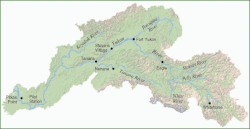Yukon River
| Yukon River | |
|---|---|
 | |
 | |
| Physical characteristics | |
| Mouth | Bering Sea |
| Length | 3,700 km (2,300 mi) |
The Yukon River is a major watercourse of northwestern North America. Over half of the river lies in the U.S. state of Alaska, with the most of the other portion lying in and giving its name to Canada's Yukon Territory, and a small part of the river near the source located in British Columbia. The river is 3,700 km (2,300 mi) long and empties into the Bering Sea at the Yukon-Kuskokwim Delta. The average flow is 6,430 m³/s (227,000 ft³/s).[1] The total drainage area is 832,700 km² (321,500 mi²),[2] of which 323,800 km² (126,300 mi²) is in Canada. By comparison, the total area is more than 25% larger than Texas or Alberta.
The longest river in Alaska and the Yukon Territory, it was one of the principal means of transportation during the 1896–1903 Klondike Gold Rush. Paddle-wheel riverboats continued to ply the river until the 1950s, when the Klondike Highway was completed.
Yukon means "great river" in Gwich'in. The river was called Kwiguk, or "large stream", in Yupik. The Lewes River is the former name of the upper course of the Yukon, from Marsh Lake to the confluence of the Pelly River at Fort Selkirk.
Course

The generally accepted source of the Yukon River is the Llewellyn Glacier at the southern end of Atlin Lake in British Columbia. Others suggest that the source is Lake Lindeman at the northern end of the Chilkoot Trail. Either way, Atlin Lake flows into Tagish Lake, as eventually does Lake Lindeman after flowing into Lake Bennett. Tagish Lake then flows into Marsh Lake. The Yukon River proper starts at the northern end of Marsh Lake, just south of Whitehorse. Some argue that the source of the Yukon River should really be Teslin Lake and the Teslin River, which has a larger flow when it reaches the Yukon at Hootalinqua. The upper end of the Yukon river was originally known as the Lewes River until it was established that it actually was the Yukon. North of Whitehorse, the Yukon River widens into Lake Laberge, made famous by Robert W. Service's "The Cremation of Sam McGee." Other large lakes that are part of the Yukon River system include Kusawa Lake (into the Takhini River) and Kluane Lake (into the Kluane and then White River).
The river passes through the communities of Whitehorse, Carmacks, and Dawson City in the Yukon Territory, and into Circle, Fort Yukon, Stevens Village, Tanana, Ruby, Galena, Nulato, Grayling, Holy Cross, Russian Mission, Marshall, Pilot Station, St. Marys (which is accessible from the Yukon at Pilot Point), and Mountain Village. After Mountain Village, the main Yukon channel frays into many channels, sprawling across the delta. There are a number of communitites after the "head of passes," as the channel division is called locally: Nunum Iqua, Alakanuk, Emmonak, and Kotlik. Of those delta communities, Emmonak is the largest with roughly 760 people in the 2000 census. Emmonak's gravel airstrip is the regional hub for flights.
Bridges


Despite its length, there are only four vehicle-carrying bridges across the river:
- the Lewes Bridge, north of Marsh Lake on the Alaska Highway;
- the Robert Campbell Bridge, which connects the Whitehorse suburb of Riverdale to the downtown area,
- the Yukon River Bridge in Carmacks, on the Klondike Highway; and
- the E. L. Patton Yukon River Bridge, north of Fairbanks on the Dalton Highway.
A car ferry crosses the river at Dawson City in the summer; it is replaced by an ice bridge over the frozen river during the winter. Plans to build a permanent bridge were announced in March 2004, although they are currently on hold because bids came in much higher than budgeted.
There are also 2 pedestrian-only bridges in Whitehorse, as well as a dam across the river and a hydroelectric generating station. The construction of the dam flooded the White Horse rapids, which gave the city its name, and created Schwatka Lake.
The river flows into several parklands and refuges including:
- Innoko National Wildlife Refuge
- Nowitna National Wildlife Refuge
- Yukon-Charley Rivers National Preserve
- Yukon Delta National Wildlife Refuge
- Yukon Flats National Wildlife Refuge
Tributaries
Yukon Territory

- Takhini River
- Big Salmon River
- Little Salmon River
- Nordenskiold River
- Teslin River
- Pelly River
- Stewart River
- White River
- Sixtymile River
- Indian River
- Klondike River
- Fortymile River
Alaska
- (tributaries in the Yukon)
- (tributaries in Alaska)
- Chandalar River
- Big Salt River
- Hess Creek
- Fish Creek
- Coal Creek
- Texas Creek
- Tanana River
- NC Creek
- Tozitna River
- Lynx Creek
- Bering Creek
- Nowitna River
- Big Creek
- Melozitna River
- Ruby Slough
- Yuki River
- Yuki River
- Kala Creek
- Galena Creek
- Bishop Creek
- Koyukuk River
- Naruto River
- Innoko River
- Reindeer River
- Kako Creek
- Engineer Creek
See also
References
- ^ Brabets, et al, 2000 Environmental and Hydrologic Overview of the Yukon River Basin, Alaska and Canada p56.
- ^ Brabets, et al, 2000 Environmental and Hydrologic Overview of the Yukon River Basin, Alaska and Canada p48.
